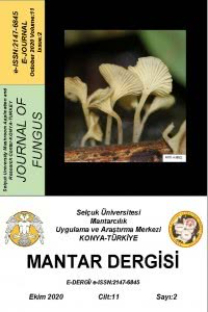Bovista plumbea F_’ers.'nın Yağ Asiti içeriklerinin Incelenmesi
Determination of Fatty Acid Contents of Bovista plumbea Pers.
___
- Akoh C.C., Min D.B., Food lipids: chemistry, nutrition, and biotechnology 3th ed., Marcel Dekker, New York (2008).
- Aktümsek A., Öztürk C., Kaşık G., Agaricus bisporus (Lange) Sing. ’un Yağ Asidi Bileşimi, Tr. J. of Biology, 22:75—79 (1998)
- Breitenbach J., Kranzlın F., Fungi of Switzerland, Volume 1—5. Verlag Mykologia CH—6000 Luzern 9, Switzerland (1983—2005).
- Bu B., Ashwood P., Harvey D., King |.B., Water J.V., Jin L.W., Fatty acid compositions ofred blood cell phospholipids in children with autism, Prostaglandins Leukot Essent FattyAcids, 74(4):21 5-21 (2006). Çolak, A., Faiz, Ö., Sesli, E., Nutritional Composition of Some Wild Edible Mushrooms,. Turkish Journal of Biochemistry. 34(1 25—31 (2009).
- Dahncke R.M., 1200 Pilze, AT Verlag Aarau, Stuttgart (1 993).
- Deshimaru R., Ishitani K., Makita K., Horiguchi F., Nozawa S., Analysis of fatty acid composition in human bone marrow aspirates, The Keio Journal of Medicine, 54(3): 50—5 (2005).
- Demirel K., Acar A., Ömeroğlu Boztepe G., Lice (Diyarbakır) Yöresi Makrofungusları, Mantar Dergisi/The Journal of Fungus, 7(1)29—39 (2016).
- Diez V.A., Alvarez A., Compositional and nutritional studies on two wild edible mushrooms from northwest Spain, Food Chemistry, 75:417—422 (2001).
- Doğan H.H., Kaşık G., Öztürk C., Aktaş S., Check/ist oprhyllophora/es of Turkey, Pakistan J. Bot., 37(2): 459—485 (2007).
- Ellis M.B., Ellis J.P., Fungi Without Gil/s (Hymenomycetes and Gasteromycetes), Chapman and Hill, London (1990).
- Jordan K., The New Guide to Mushrooms, Anness Publishing Ltd., Singapore (1996). Kaşık G., Öztürk C., Aktas S, Alkan S., Eroğlu G., Kefe Yaylası (Denizli) Yenen Mantarları, Mantar Dergisi/The Journal ofFungus, 4(2) 19—27 (2013).
- Kaya A., Contributions to the macrofungal diversity ofAtatürk Dam Lake basin, Turk Bot, 39: 62—1 72(2015).
- Kreisel H., Grundzüge Eines Natürlichen Systems der Pilze, Verlag Von J. Cramer, Stuttgart (1969).
- Li D., Lei H., Li Z., Li H., Wang Y., Lai Y., novel lipopeptide from skin commensal activates TLR2/CD36-p38 MAPK signaling to increase antibacterial defense against bacterial infection, PLoS One, 8(3):58288 (201 3).
- Longvah T., Deosthale Y. G., Compositional and nutritional studies on edible wild mushroom from northeast India, Food Chemistry, 63:331—334 (1998).
- Loor J.J., Lin X., Herbein J.H., Effects ofdietary cis 9, trans 11—18 2, trans 10, cis 12-18 2, or vaccenic acid (trans 11- 18 1) during lactation on body composition, tissue fatty acid profiles, and litter growth in mice, British Journal of Nutrition, 90, 1039—1048 (2003).
- 107 MANTAR DERGİSİ/The Journal of Fungus Ekim(201 7)8(2)104-108 Moser ., Keys to Agarics and Boleti, Gustav Fischer Verlag, Stuttgart (1983).
- Phillips R., Mushrooms and OtherFungi of Great Britain and Europe, Pan Books Ltd., London (1981 ).
- Ribeiro B., de Pinho P.G., Andrade P.B., Baptista P., Valentâo P., Fatty acid composition of Wild edible mushrooms species:A comparative study, Microchemical Journal, 93:29—35 (2009).
- Rose D.P., Effects of dietary fatty acids on breast and prostate cancers: evidence from in vitro experiments and animal studies, The American Journal of Clinical Nurition, 66(6 Suppl):15138—15228 (1997).
- Servi H., Akata |., Çetin B., Macrofungal Diversity of Bolu Abant Nature Park (Turkey), African Journal of Biotechnology, 9(24):3622—3628 (2010).
- Sesli, E., Denchev, C.M., Checklists of the myxomycetes, larger ascomycetes, and larger basdiomycetes in Turkey.
- 6th edn. Mycotaxon Checklists Online (2014). (http:/lwww.mycotaxon.com/resources! checkilsts/sein—v106— checklist.pdf): 1—136.
- Watling R., Identification of The LargerFungi, Hulton Educational Publications Ltd (1973).
- Winkler R., 2000 Pilze Einfach Bestimmen, ATV. Aarau, Schweiz (1996).
- Yllmaz A., Yıldız S., Yıldırım İ., Aydın A., Trabzon 'da Mantar Tüketimi ve Tüketim Alışkanlık/arının Belirlenmesi, Mantar Dergisi/The Journal of Fungus, 7(2)1 35-142 (201 6).
- Yilmaz N., Solmaz M., Türkekul İ., Elmastaş M., Fatty acid composition in some wild edible mushrooms growing in the middle Black Sea region of Turkey, Food Chemistry, 99:168-174 (2006).
- ISSN: 2147-6845
- Yayın Aralığı: Yılda 2 Sayı
- Başlangıç: 2010
- Yayıncı: Selçuk Üniversitesi Mantarcılık Uygulama ve Araştırma Merkezi Müdürlüğü
Türkiye Mikotası İçin Trabzon ve İstanbul İllerinden Dört Yeni Bazidiyomikota Kaydı
Selçuk Üniversitesi Alaaddin Keykubat Kampüsü (Konya) Makromantarlarına İlaveler
Gıyasettin KAŞIK, Sinan AKTAŞ, Sinan ALKAN, Celalleddin ÖZTÜRK
Bitki Patojeni Funguslarda Virulans Faktörleri
SİNAN ALKAN, HALUK ÖZPARLAK, Gökhan ZENGİN, GIYASETTİN KAŞIK
Evlerde Kullanılan Buzdolaplarının İç Ortamında Havayla Taşınan Fungusların Biyoçeşitliliği
Soner ÖZDİL, AHMET ASAN, BURHAN ŞEN, SUZAN ÖKTEN
Four New Records of Basidiomycota for the Turkish Mycota From Trabzon and İstanbul Provinces
Entoloma majaloides (Entolomataceae): Türkiye Mikotası İçin Yeni Bir Kayıt
Ertuğrul SESLİ, Ayşegül TOPCU SESLI
Selçuk Üniversitesi Alaeddin Keykubat Kampüsü (Konya) Makromantarlarına Ilaveler
GIYASETTİN KAŞIK, SİNAN AKTAŞ, SİNAN ALKAN, CELALEDDİN ÖZTÜRK
Two New Records for Turkey: Oph obolus erythrosporus and Leptosphaeria modesta
